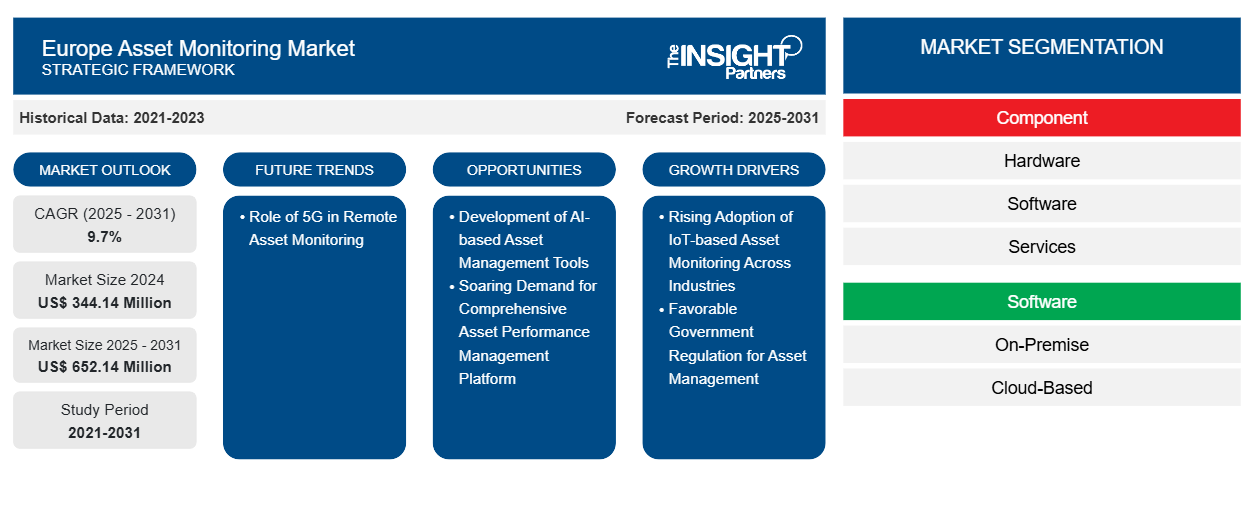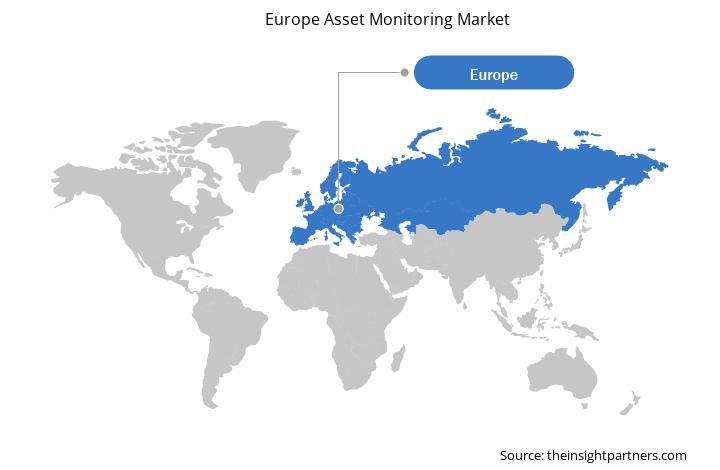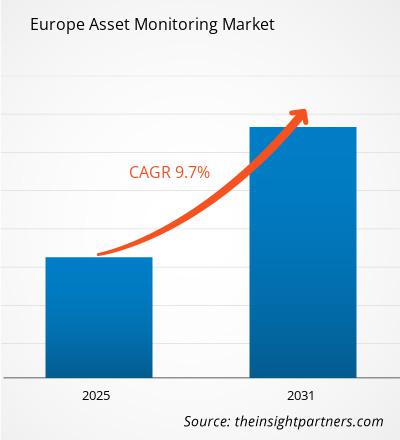2024年,欧洲资产监控市场规模为3.4414亿美元,预计到2031年将达到6.5214亿美元;预计 2025-2031年期间的复合年增长率为9.7%。5G在远程资产监控中的作用可能仍将是市场的关键趋势。
欧洲资产监控市场分析
物联网资产监控在各行各业的日益普及,以及政府对资产管理解决方案的有利监管,正在推动其在欧洲的应用。工业扩张、对降低机械设备维护成本的日益重视,以及对工作场所安全的担忧,进一步推动了其应用。技术进步、市场参与者对开发基于人工智能的资产管理工具的关注,以及对全面资产绩效管理平台日益增长的需求,进一步推动了市场的增长。此外,随着研发活动的蓬勃发展,5G技术在加快资产监控流程方面的优势,以及企业实施成本削减战略的优势,预计将在预测期内为市场创造增长机会。
欧洲资产监控市场概览
资产监控使用硬件(例如传感器、RFID标签和物联网设备)、软件和服务来定期监控资产状况和性能。它使企业能够确保其资产在适当的时间以所需的数量和质量可用。该流程鼓励企业及时维护和保养机器设备、补充库存,并在生产力下降之前跟踪生产数量。资产监控硬件和软件的无缝集成,通过提供实时资产数据洞察,支持企业降低开支。资产监控解决方案提供的持续、准确、预测和实时监控等优势正在推动其应用。资产监控解决方案通过监控包括机械、建筑物、家具和汽车在内的资产,帮助企业安排维护计划。
定制此报告以满足您的要求
您可以免费定制任何报告,包括本报告的部分内容、国家级分析、Excel 数据包,以及为初创企业和大学提供优惠和折扣
欧洲资产监控市场:战略洞察

- 获取此报告的顶级关键市场趋势。此免费样品将包括数据分析,从市场趋势到估计和预测。
欧洲资产监控市场驱动因素和机遇
各行各业越来越多地采用基于物联网的资产监控
基于物联网的资产监控应用于仓库、制造和物流设施、数据中心、制造业、供应链和医院等行业。这些行业使用基于物联网的资产监控解决方案来控制运营、提高效率并加快任务完成速度。这些解决方案与基于物联网的传感器集成,可在资产未经授权的移动、篡改或盗窃时向资产管理人员发出警报。企业可以使用全球定位系统 (GPS)、射频识别 ( RFID ) 和地理围栏来提高安全性并减少财务损失,从而避免或应对资产损失。它还有助于实时资产监控,使企业能够了解其资产的确切位置和状况。各行各业越来越多地采用和实施持续监控解决方案,这推动了基于物联网的资产监控解决方案的使用率,以实时监控其实物资产。其他行业,包括重型设备、数据中心和建筑业,也在采用基于物联网的资产监控解决方案来实现流程自动化并降低运营成本,这推动了欧洲资产监控市场的增长。
基于人工智能的资产管理工具的开发
人工智能 (AI) 技术正在通过增强资产监控功能来彻底改变资产监控。AI 驱动的资产监控解决方案利用历史数据和实时传感器输入来预测资产(包括机械设备)的性能。这种主动方法使企业能够在问题出现之前进行定期维护,从而最大限度地减少意外停机时间并延长资产的使用寿命。它可以减轻磨损,延长机械设备的使用寿命,同时确保运营效率。市场参与者正在部署和推出集成 AI 的资产监控解决方案,以便在故障发生前检查资产数据并确定维护需求;这有助于重工业通过提高运营效率来减少运营停机时间。AI 平台可以跟踪和监控实时性能,并可以检测资产中的异常情况。AI 从物联网传感器和其他来源生成数据,并提醒操作员解决问题,使行业能够以最高效率运行,并将停机时间降至最低。AI 的预测能力正在影响资产监控解决方案的未来运营。因此,在预测期内,向更智能、准确、可靠、数据驱动和实时资产监控技术的转变预计将为欧洲资产监控市场创造丰厚的增长机会。IoT sensors and other sources and alerts operators to address the issues, enabling industries to operate at peak efficiency with minimal downtime. The predictive capabilities of AI are influencing the future operations of asset monitoring solutions. Thus, the shift toward more intelligent, accurate, reliable, data-driven, and real-time asset monitoring technologies is expected to create lucrative growth opportunities for the Europe Europe Asset Monitoring Market during the forecast period.
欧洲资产监控市场报告细分分析
有助于得出欧洲资产监控市场分析的关键部分是组件、企业规模和最终用户。
- 从组成部分来看,欧洲资产监控市场分为硬件、软件和服务。硬件部分在2024年占据了最大的市场份额。软件部分进一步细分为本地软件和云端软件。
- 根据企业规模,欧洲资产监控市场分为中小企业和大型企业。大型企业在2024年占据了最大的市场份额。
- 就终端用户而言,欧洲资产监控市场细分为制造业、化工和石化产品、石油和天然气、医疗保健、建筑业及其他。制造业在2024年占据了欧洲资产监控市场的最大份额。
欧洲资产监控市场份额(按地区)分析
- 欧洲资产监控市场细分为芬兰、瑞典、比利时、荷兰、德国和欧洲其他地区。2024年,德国占据了市场主导地位,其次是欧洲其他地区和荷兰。
- 欧洲政府和科技公司对人工智能、数字孪生、5G 和基于物联网 (IoT) 的设备等先进技术优势的认识正在不断提高。欧洲各国政府计划于 2025 年 9 月 24 日至 25 日在阿姆斯特丹 RAI 展览中心举办物联网技术博览会。此次博览会旨在提高人们对物联网、数字孪生与企业转型、智能基础设施与自动化、边缘平台以及数据与分析等尖端技术优势的认识。随着企业在资产监控中采用自动化,物联网生态系统的扩张直接影响着欧洲资产监控市场。基于物联网的设备,例如智能传感器、GPS 追踪器、RFID 标签和读取器、状态监测设备、联网摄像头、门禁系统等,已被制造业、运输业、物流业和医疗保健业广泛用于实时资产监控。它们提供持续实时的资产监控,使资产管理人员能够快速访问资产位置、状况、状态和整体健康状况数据;这有助于资产管理人员减少停机时间,并确保及早发现机器和设备问题。物联网基础设施的不断发展,促进了可靠、高性能资产监控解决方案的采用,这些解决方案支持资产管理人员进行实时资产监控。因此,对先进资产监控软件日益增长的需求预计将为欧洲资产监控市场创造未来的增长机会。
欧洲资产监控市场区域洞察
Insight Partners 的分析师已详尽阐述了预测期内影响欧洲资产监控市场的区域趋势和因素。本节还讨论了欧洲资产监控市场在北美、欧洲、亚太地区、中东和非洲以及南美和中美的细分市场和地域分布。

- 获取欧洲资产监控市场的区域特定数据
欧洲资产监控市场报告范围
| 报告属性 | 细节 |
|---|---|
| 2024年的市场规模 | 3.4414亿美元 |
| 2031年的市场规模 | 6.5214亿美元 |
| 全球复合年增长率(2025-2031) | 9.7% |
| 史料 | 2021-2023 |
| 预测期 | 2025-2031 |
| 涵盖的领域 | 按组件
|
| 覆盖地区和国家 | 欧洲
|
| 市场领导者和主要公司简介 |
|
欧洲资产监控市场参与者密度:了解其对业务动态的影响
欧洲资产监控市场正在快速增长,这得益于终端用户需求的不断增长,而这些需求的驱动因素包括消费者偏好的不断变化、技术进步以及对产品优势的认知度不断提高。随着需求的增长,企业正在扩展其产品线,不断创新以满足消费者需求,并利用新兴趋势,从而进一步推动市场增长。
市场参与者密度是指特定市场或行业内企业或公司的分布情况。它表明特定市场空间内竞争对手(市场参与者)的数量相对于其规模或总市值而言。
在欧洲资产监控市场运营的主要公司有:
- 资产监控解决方案有限公司
- 横河电机公司
- 卡姆林集团
- 艾默生电气公司
- 通用电气维尔诺瓦公司
- 甲骨文公司
免责声明:以上列出的公司没有按照任何特定顺序排列。

- 获取欧洲资产监控市场顶级关键参与者概览
欧洲资产监控市场新闻及最新发展
欧洲资产监控市场评估通过收集一手资料和二手资料后进行的定性和定量数据进行,这些数据包括重要的公司出版物、协会数据和数据库。欧洲资产监控市场的一些发展情况如下:
- 甲骨文宣布推出全新 Oracle 云基础设施 (OCI) 分布式云创新,以满足全球对其 AI 和云服务日益增长的需求。借助 Oracle 分布式云,客户可以在边缘、数据中心、跨云或公有云部署 OCI 的 150 多项 AI 和云服务。这些创新有助于满足数据隐私、自主 AI 和低延迟需求。(来源:甲骨文公司,新闻稿,2024 年 9 月)
- 全球能源和电信电缆系统行业领导者普睿司曼集团宣布,公司将参加物联网世界大会 (IOTHINGS WORLD)。该大会是一项专注于物联网数字化转型的领先活动。普睿司曼集团在会上展示了PRY-CAM:用于电网和资产监控的人工智能和传感技术。
(来源:普睿司曼集团,新闻稿,2021年9月)
欧洲资产监控市场报告覆盖范围及交付成果
《欧洲资产监控市场规模和预测(2021-2031)》对以下领域进行了详细的市场分析:
- 欧洲资产监控市场规模以及区域和国家层面涵盖的所有主要市场领域的预测
- 欧洲资产监控市场趋势以及市场动态,例如驱动因素、限制因素和关键机遇
- 详细的 PEST 和 SWOT 分析
- 欧洲资产监控市场分析涵盖主要市场趋势、区域框架、主要参与者、法规和最新市场发展
- 行业格局和竞争分析,涵盖市场集中度、热图分析、知名参与者以及欧洲资产监控市场的最新发展
- 详细的公司简介
- 历史分析(2 年)、基准年、预测(7 年)及复合年增长率
- PEST和SWOT分析
- 市场规模、价值/数量 - 全球、区域、国家
- 行业和竞争格局
- Excel 数据集
近期报告
客户评价
购买理由
- 明智的决策
- 了解市场动态
- 竞争分析
- 客户洞察
- 市场预测
- 风险规避
- 战略规划
- 投资论证
- 识别新兴市场
- 优化营销策略
- 提升运营效率
- 顺应监管趋势




















 获取免费样品 - 欧洲资产监控市场
获取免费样品 - 欧洲资产监控市场